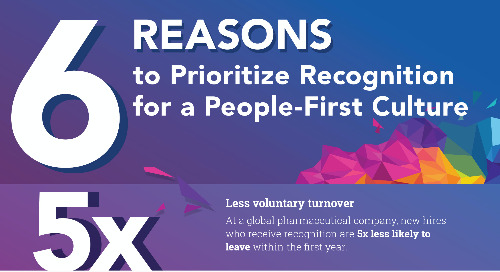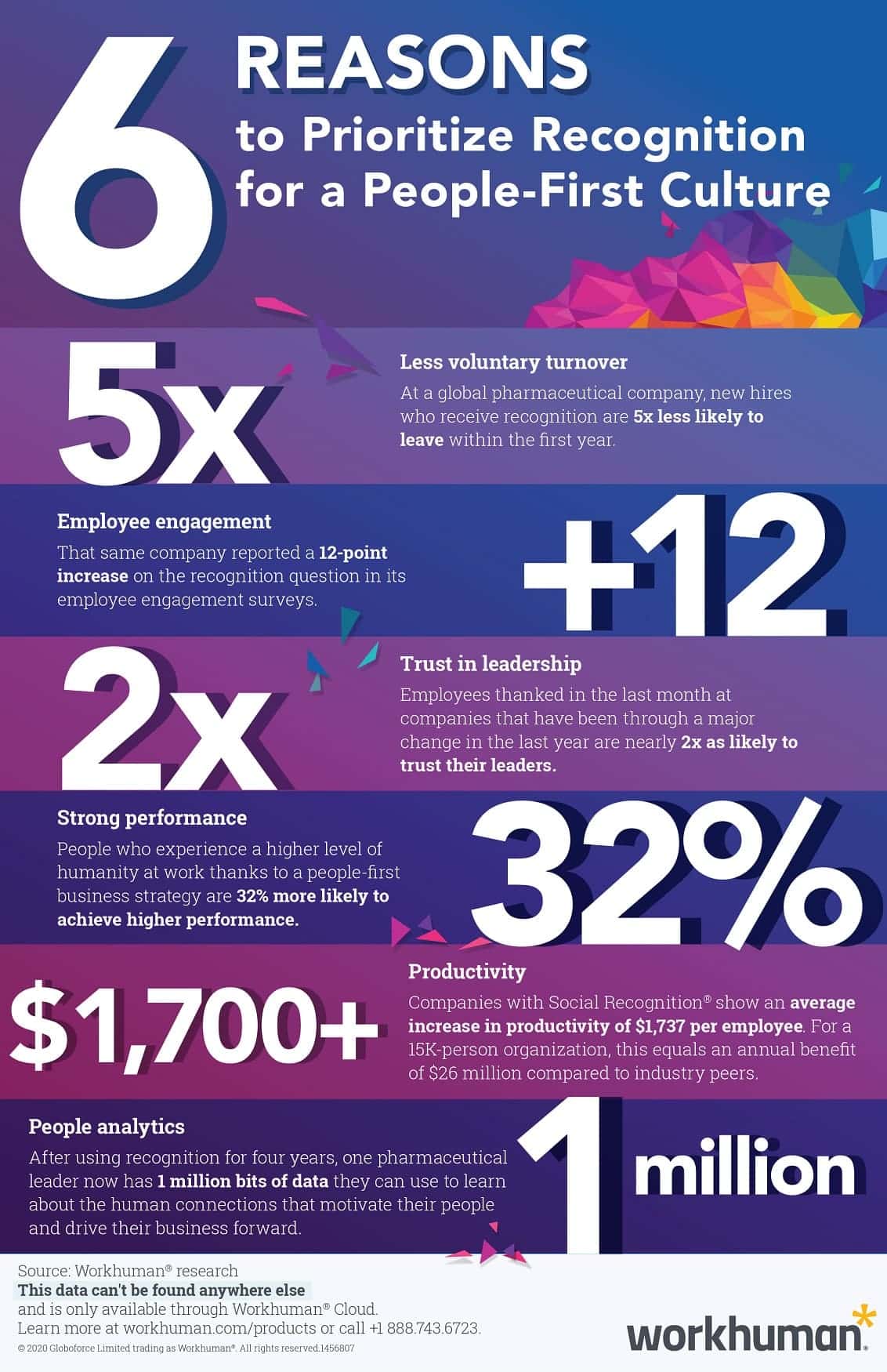How To Create a People-First Culture Through Recognition

What can creating a people-first culture do for your organization? For starters, it can reduce turnover, increase engagement, and improve productivity. Employee recognition helps promote a healthy workplace culture.
Knowing how to support your teams can be difficult. Especially with so many competing HR initiatives. Following the data is one of the best ways to ensure a successful and thriving workplace. Creating an employee-first culture can unlock the true potential of your business.
What is a people-first culture?
An employee-first or people-first company culture is a company-wide approach that aims to recognize employees in order to help them feel more connected and motivated.
The value of putting people first extends beyond just your business. It aims to put people over profit and help the employee's within your organization, too.
When people feel appreciated and noticed by their company and senior leaders, they're less likely to seek other opportunities and their productivity increases.
The result? Higher levels of job satisfaction among employees, greater talent acquisition, and improved employee retention. The business sees benefits, too, primarily in increased productivity, employee engagement, and improved collaboration.
Culture doesn't just inform how nice it is to work for your organization; it also drives profitability and long-term success.
Discover how Social Recognition® and the rest of the Workhuman Platform can transform your organization’s culture into one with gratitude at the center. Request a demo today!
Companies that employ this business strategy see an average productivity increase of $1,737 per employee. Putting people at your company first isn't just the right thing to do — it's the business-savvy thing to do.
What are some examples of employee-first culture?
When companies implement these strategies, benefits abound. Taking a look at some real-life examples can help illustrate the success of this approach.
People first is so much more than words on a page, and Baystate Health saw the benefits firsthand. Like so many companies before them, budgeting restrictions meant some of the first things to go were employee recognition initiatives.
Luckily, the employees spoke up against the slide toward a toxic work culture, expressing a need for a better strategy.
After only one year, employees produced 15,000 moments of recognition, and 66% of the company's 12,000 team members received the well-deserved praise they so desperately needed.
The nurses who received this praise were, in many cases, over seven times less likely to leave.
Prioritizing culture gives back in a way few other solutions can. Since Baystate Health has put its full attention on a people-first strategy, the results have been extraordinary.
Give the Baystate Health webinar a view if you're interested in learning more about the profound impact that their strategy has had.
6 steps for cultivating a people-first culture

Changing your company's culture may feel daunting, but it doesn't have to. Here's how you can incorporate these initiatives into your own HR strategy:
1. Establish organization-wide alignment in your business processes
The first step to implementingOpens in a new tab a people-first approach that prioritizes the employee is to align the company mission statement with that goal. Implementing a peer-to-peer recognition solution or administering surveys isn't enough on its own.
When everyone in the company commits to changing the culture, that's when real change can happen. Without that, any implementations you try to put into effect will fall flat.
Teach leaders and senior executives about the importance of recognition and the goals you hope to achieve. If they don't understand it when you bring up the human perspective, they can certainly appreciate the numbers. Keeping top talent, increasing productivity, and maximizing alignment should be the top goals of any successful company. Realizing that recognition and employee-first strategies get you there is key to a prosperous and long-term cultural shift.
2. Develop employee feedback opportunities
A people-first approach is all about prioritizing the employee experience and well being. That starts with having a firm grasp of what the employee experience is.
Offer meaningful and diverse opportunities to invite employee feedback. The way you accomplish this can be unique to your organization.
Company-wide surveys are a good starting point, and they can help you get an overall sense of the sentiments among employees. However, they might not leave you with any actionable solutions.
Encourage more than one type of feedback. Do this by understanding your employees. Right now, for millennials and Gen Z workers, social media is where the conversations are happening.
Expecting employees to come to you with their frustrations or concerns isn't a good approach. Engage with employees in meaningful ways and strive to understand their perspectives.
This can help you better direct your energy toward the solutions employees actually care about.
3. Prioritize putting people first by recognizing contributions
Recognition is the cornerstone of an employee-first strategy. Recognition from both peers and leaders is so important for helping employees feel seen and valued by their organization.
Employees bring diverse skills and accomplishments, and your praise for those contributions should be just as diverse. Recognition helps connect employees to one another and to leadership, reminding them that the work they do matters.
When the energy employees give to their jobs feels seen and celebrated, they're more likely to keep investing that energy in meaningful ways.
Creating a new culture doesn't happen overnight. Incentives that go along with the recognition system are a great way to motivate people to engage with one another, especially on a new or unfamiliar platform.
Try a servant leadershipOpens in a new tab approach to learn how supporting employees can actually look.
4. Give leaders strategies for establishing trust and empathy
Empower employees to be leaders and give your leaders the tools they need to support their teams. One of the most authentic ways to garner feedback is through constructive and reciprocal one-on-ones.
When employees feel like their ideas matter and their feedback is taken seriously, they're more likely to offer it when they have opportunities.
Coach leaders on how to be empathetic and supportive toward those on their teams. Show leaders that accomplishing goals depends on the strength of their team, and encourage them to protect their employeesOpens in a new tab before focusing on external relationships.
5. Encourage active employee engagement through real-time feedback
When you set achievable expectations for employees and actively commit to helping them grow through employee development, their ability to rise to the occasion may surprise you.
Deliver honest feedback in real-time and allow employees to implement the solutions that make them better. When they do it, commend it. Acknowledge the change and reward the behavior you want to see.
Communication goes two ways. Empowering leaders to have dynamic and open dialogues with employees represents nothing but positive changes and growth for your teams and your company.
Feedback promotes people-first, meaning two-way conversations can encourage an employee-centric workplace where engagement is celebrated.
6. Embrace employees first to create a positive workplace culture
Today, only one in four employees strongly agree that they feel connected to their company culture. Embracing change can help you shift the sentiment.
Creating an authentic and vibrant culture requires everyone's commitment. Company-wide alignment of values is essential for your strategy to feel authentic and true.
Employee-first culture is not one-size-fits-all, it's not an employee appreciation breakfast once a year, and it's certainly not something to tack to the bottom of your core values list without following through.
Living your values lets employees know you mean what you say. Listen and incorporate feedback. Empower employees to grow and become leaders.
Align your company toward a vision of employee fulfillment and success. Make their priorities your priorities. If your strategy is genuine, employees will feel cared about, and they'll reciprocate. Loyalty is a two-way street, and actions speak louder than a core values poster in the break room.
To gain more insight into some of the cultural shifts and realities we're seeing, check out our podcast on how recognition can transform your culture.
FAQs
Here are some answers to commonly asked questions about a people-first culture:
1. Why is it important to put employees first?
It's important to put employees first because doing so creates a work environment people are excited about. Your employees will be more likely to feel satisfied in their roles.
They'll perform at a higher level with greater consistency, and they'll function better as a team, because they feel they’re doing meaningful work. People care about the companies they work for when the companies they work for care about them.
2. How do you demonstrate a people-first culture?
Starting a successful people-first culture depends entirely on an organization's ability to live its values. It starts with meaningful and authentic recognition that extends beyond just keeping up with appearances.
People-first leadership, prioritized employee recognition, and giving employees plenty of opportunities for feedback are the cornerstones of a successful employee-first workplace.
3. How do you promote a people-first strategy?
One of the best ways to promote a people-first strategy is the employee solutions with proven track records. Workhuman offers recognition-based solutions that can get your company on track and help employees feel motivated to participate.
Promoting a people-first approach depends on every level of your organization engaging with and committing to creating a positive workplace environment.
Evidence-based solutions developed for actual companies and real people can help you achieve greater alignment and employee satisfaction.
They put you ahead of the national shift we're seeing companies take that emphasizes employee growth, happiness, and development.
Invest in an approach that has delivered marked success for countless companies and discover how a people-first strategy can work for you and your company.
RELATED POSTS
11 Tips for Building Trust in the Workplace